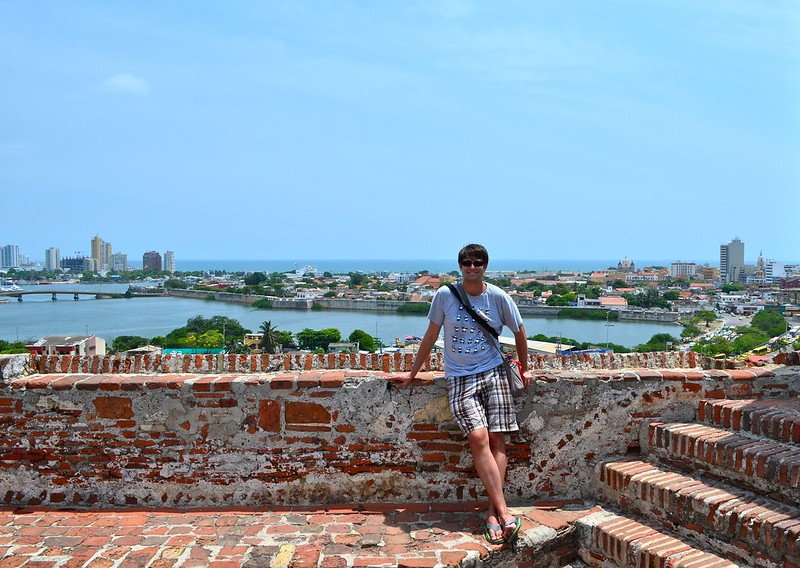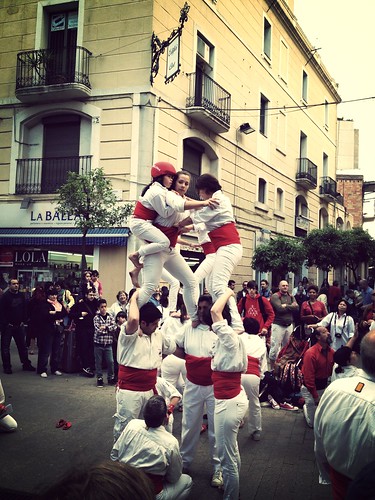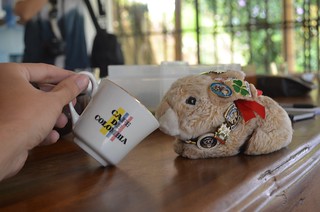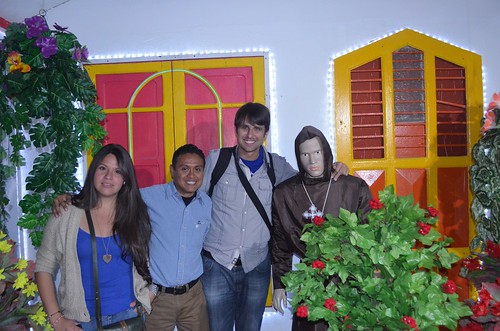
Here’s why my Spanish didn’t improve while in Spain (too much Chinese!), how I used small daily habits (with Duolingo!) to make up for it, and how my Spanish grew up while in Colombia.
I just got back a couple weeks ago from Colombia where I can happily claim to have “managed” quite well in Spanish. I can’t claim to have become “fluent” in Spanish by age 30. But I have arrived at Spanish proficiency.
It’s been almost 9 months since I started talking about my progress on learning Spanish. So, I’m overdue on an update.
Why My Spanish Didn’t Improve Much in Spain: Speaking Chinese in Spain
While this “Spanish learning goal” started officially when I first arrived in Barcelona, Spain, I didn’t make that much progress while in Spain. Excuses are just that, excuses! But mostly I didn’t make much progress since I ended up making quite a few Chinese and English speaking friends while in Barcelona. So, I was mostly speaking Chinese and English.

Many Spanish cities are peppered now with Chinese immigrants, and it become quite easy for me remain mostly in “Chinese” mode there. I lived with a Chinese family. I’d buy my groceries at a Chinese grocer. I’d get my beer from a Chinese convenience store. When I wanted to go out to get a beer, I’d more often then not go to my Chinese-owner bar. To take it to the extreme, when I wanted sushi I’d go to the Chinese-owned sushi shop.
Many of the Chinese can manage their work situation in Spanish, but most are not conversational or comfortable in Spanish, so they were quite happy to converse with me in Chinese. Also, unlike in China, where some Chinese treat most foreigners like babbling fools, the Chinese immigrants interacted with me in a normal way.
For me, it became kind of a statement of pride that I could live quite fluently by speaking mostly in Chinese IN Spain. I did gain enough restaurant and coffeeshop Spanish, but, not surprisingly my Spanish didn’t improve that much while in Spain. In fact, I’d say that my Chinese improved more in Spain than my Spanish did.
Fortunately, along with my previously noted Spanish learning resources, I found a pretty amazing site and now app to “grow” my Spanish: Duolingo.
My Personal Spanish Learning Buddy: Duolingo
I’m a huge fan of Duolingo, and I often recommend it to my friends around the world. For the languages it offers, it’s one of the language learning resources out there. They really get the “gamification” aspect of language learning.
Duolingo is a recent, educational startup that has gained a lot of attention and users over the last year or so. When I started using it, it didn’t even have an iPhone app, so I started by using the website. But once they released their iPhone app, Duolingo become almost a daily obsession for me. At least once a day, I’d open the app and continue on my learning path towards fluency.
Basically, Duolingo is a game-ified translation learning method where you go through different concepts by translating expressions between English and your target language (in my case, Spanish). You work at mastering different vocabulary and grammatical concepts as you move towards “mastery.”
Ultimately, it’s a pretty interesting and enjoyable “journey” so the learning growth comes pretty naturally.
Daily Spanish? Really?
I’m a big believer in the “learn a little everyday” approach to learning anything, especially a foreign language. In my case, I committed to at least a bit of Spanish study every, single day. Except for a few times, I’ve kept to this commitment.
Since I’m also pretty obsessive about tracking my time and documenting my daily achievements and study goals, I can claim to know my daily goal fulfillment and the time I’ve put into it.
For tracking small stuff, I use AskMeEveryDay, which is a simple service which sends you an email or text message where you respond back and they store your response. I track a number of daily questions but for Spanish, the question is dead-simple: Did I study Spanish?
I’m currently on a 90+ day study streak for Spanish. Meaning I’ve studied Spanish for at least a few minutes every day since June 30th (which only was broken due to a serious stomach sickness in Istanbul). Before that break in the chain, I had about 2-3 months where I had been somewhat streaky but I had been studying about 90% of the days recorded.
In terms of time, since May 2013 (which is when I started obsessing about time tracking using Toggl), I had logged 38 hours 43 minutes and 04 seconds of conscious Spanish study time, including a monthly high of 13 hours and 13 minutes in May.
While that’s not a huge time allotment and I could easily justify up-ing my time commitment to Spanish study, it’s easy to see that the daily dosages with SpanishPod and Duolingo had worked well to prep me for my trip to a more intensive Spanish-speaking experience: Colombia.
How was my Spanish in Colombia?

First off, why did I go to Colombia? The honest answer is that this was one of cheapest, international flights from the US where I found myself over the summer. I had a Colombian-American friend who gave me the urge a few years ago, and this summer I had a couple months to kill before I wanted to get back to Asia. So, Colombia it was.
Upon arriving in Bogota, I didn’t hesitate in speaking Spanish and did my best to strike up a conversation with my first taxi driver from the airport. I explained to her in Spanish that I could speak Chinese and some basic elements of the Chinese language. Obviously speaking about stuff I knew was easiest at this point. From there, I did quite a few touristy things but made sure I stayed in local hotels where Spanish was pretty much required.
My biggest “Spanish” challenge was a few days after arrival at Startup Weekend Cartagena. The existence of a Startup Weekend was one of my “justifications” for my traveling to Colombia. I wanted to give myself a bit of “work” pressure and hopefully meet some locals. I achieved both and mostly in Spanish!
From there, I went on a several week journey (which I hope to detail soon in its own blog post!) across several cities and regions of Colombia. Obviously there were temptations to speak in English but on multiple occasions I forced myself into a place and context where I had to do my best in Spanish: visiting a Colombian friend’s family in Barranquilla, trekking in Tayrona with a Colombian from the south, and staying for a week with a local Colombian family in Medellin. Each were challenges but the exposure and practice were great.
Compared to my consciously-logged Duolingo and SpanishPod study sessions, it’s difficult to quantify the study time when you are immersed in the country, but the constant exposure, while very tiring at first, significantly improved my comfort in listening and understanding longer conversations.
Importantly these experience prepared me for arriving back in Bogota after a month or so criss-crossing Colombia. During my travels, I had made a few contacts, including an invite to help mentor at Startup Weekend Bogota. This experience gave me even more friends, which helped me do a bit more Spanish-speaking “socializing,” i.e. partying, dancing, etc. afterwards.

These experiences lead to my best and most intense Spanish-speaking adventure in Colombia: the Salt Cathedral. This is definitely a story worth retelling in its own post soon. But here are the broad lines:
I left my Bogota hotel to head to Villa de Leyva, but due to a country-wide strike I couldn’t leave the bus station for my intended destination a few hours north of Bogota. Instead I ended up with a local Colombian girl and her Ecuadorian friend. We proceeded north by bus to the Salt Cathedral, where after an amazing visit (checkout the photos!), we were stranded there for the night. Through this whole experience over two-full days, I managed to understand and speak entirely in Spanish.
From Gringo to Chingro

Over my weeks in Colombia, I managed to go from observer to participant in Spanish. While I can’t claim to have reach fluency, my confidence and comfort levels in Spanish are much improved. I’d say I’m now “proficient” in Spanish, which is pretty amazing considering the minimal time effort I put in, compared to tons of classes and tutors, for example.
During my travels, I met lots of amazing people in Colombia, but only one can claim to have “gifted” me a new nickname: Chingro.
While in Medellin, I went out a couple nights with a few of the other people staying at my Colombia homestay, including one of the sons. He was a pretty funny that didn’t make much of an effort to relegate his Colombian Spanish. A few times I struggled to understand his expressions, but he was such a playful guy that it hardly matter.
Late into our second evening out as everyone’s energy started to ebb, he called out to me, “Hey Chingro, como estas?”
Since they all knew that I mostly lived in China and could speak Chinese, I had taken on an identity that was more than just being a typical American or “gringo.” That night he grafted onto my gringo-ness something of my Asian-ality and thus: Chingro was born.
